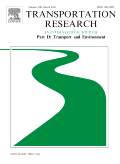Analysis of a Proposed Mechanism for Carbon-Neutral Growth in International Aviation
In October 2013, the International Civil Aviation organization (ICAO) announced that it would put in place a market-based mechanism to cap net greenhouse gas emissions from international civil aviation at 2020 levels. This paper analyses the obligations that would be placed on real airlines under an initial draft “Strawman” proposal that was originally formulated as a starting point for discussions within ICAO, and the extent to which such a proposal would succeed in keeping emissions at or below the desired level. The provisions of the ICAO proposal were then applied to more than 100 existing airlines. In order to protect commercial sensitivities, we used hierarchical cluster analysis to identify groups of different types of airlines. We report the results for these groups rather than for individual airlines. While ambiguities in the Strawman proposal complicated the analysis, we found that, depending on their size and rate of growth, airlines will be required to offset very different proportions of their emissions from international flights. A system of de minimis exemptions, as currently proposed, would benefit some rich countries as well as poor ones. Targeting such exemptions more narrowly would raise practical difficulties, which we describe. We conclude by recommending that ICAO design and implement a much simpler system; and propose one alternative.

